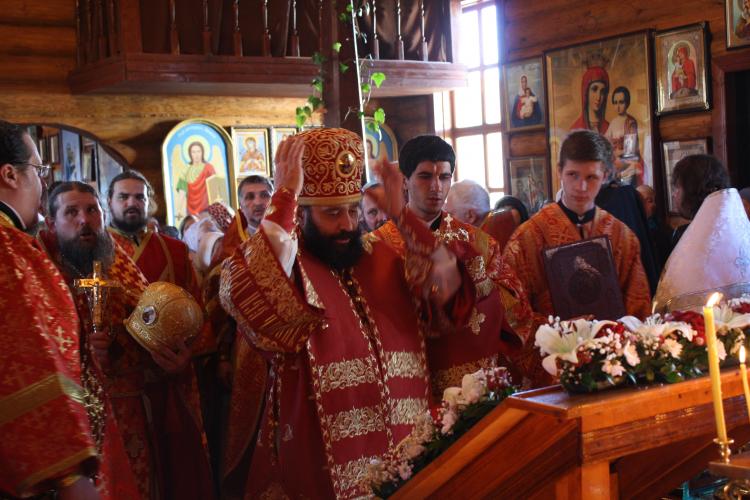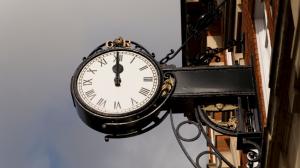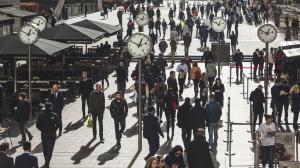
Best Comet of 2025?
C/2024 G3 (ATLAS) has already become very faintly visible to the naked eye for observers in the Southern Hemisphere.
Many Orthodox Christians annually celebrate Christmas Day on or near January 7 to remember Jesus Christ’s birth, described in the Christian Bible. This date works to the Julian calendar that pre-dates the Gregorian calendar, which is commonly observed.

Some Orthodox Christians visit a church to pray or reflect on inner thoughts in the lead up to the Orthodox Christmas Day.
©bigstockphoto.com/gutaper
Orthodox Christians in central and eastern Europe and other parts of the world celebrate Christmas on January 7. The Christmas dates around January 7 may vary among some churches. The day is a time of reflection, inner thoughts and healing in many eastern European countries. Many Orthodox Christians fast before January 7, usually excluding meat and dairy products. Foods may include:
Christmas Day, on the other hand, is a day for feasting and enjoying the company of friends and family members. The Christmas meal usually includes meat and different types of pastries. One traditional Russian Christmas dish is baked goose with apples.
The type of food and activity may vary depending on the country’s culture and traditions. In some Orthodox Christian cultures, people walk in procession to seas, rivers and lakes as part of the liturgy on the Orthodox Christmas Day. They make holes in the ice to bless the water if it is frozen. Little importance is given to gift exchanges and the commercialized Christmas.
Some Orthodox Christians observe the Nativity and Adoration of the Shepherds (those who visited baby Jesus) on January 6, followed by the Adoration of the Magi (three wise men or kings) on January 7. Church liturgies on Orthodox Christmas Eve (January 6) may be longer than usual but many people find them inspiring.
Christmas Day is a public holiday on January 7 in countries such as Belarus, Egypt, Ethiopia, Georgia, Kazakhstan, Macedonia, Moldova, Montenegro, Serbia, Russia, and Ukraine. Some countries, such as Armenia, observe Christmas Day on January 6. The January 7 celebration of Christmas Day is not a nationwide public holiday in countries such as Australia, Canada, the United Kingdom or the United States.
Christmas celebrates the birth of Jesus Christ, who many Christians believe is the son of God. His birth date is unknown because there is little information about his early life. The Gospel of St Matthew in the Bible claims he was born during Herod the Great’s reign. Herod, who was a king of Judaea, died in 4 BCE. Many Christians celebrate Jesus’ birthday on December 25 but there are some who hold tradition by observing the date on January 7.
Christmas on January 7 is also known as Old Christmas Day. Eleven days were dropped to make up for the calendar discrepancy that accumulated with Julian calendar when England and Scotland switched from the Julian to the Gregorian calendar in 1752. Many people, especially in rural areas, did not accept the loss of these 11 days and preferred to use the Julian calendar.
Many Orthodox churches recognize the holiday dates according to the Julian calendar. Christmas is still on December 25 in the Julian calendar so the January 7 date is only valid between 1901 and 2100 The Gregorian date for Orthodox Christmas will be January 8 in 2101 if the Julian calendar is still used.
The Julian calendar was revised in 1923 and this version is more in line with the Gregorian calendar. A few Orthodox churches follow the revised Julian calendar but most Orthodox churches follow the more traditional Julian calendar, which has the original dates for Christian observances prior to the Gregorian calendar’s introduction.
Saint Nicholas, who is the patron saint of Russia, sailors and children, represents the kind, good, and giving spirit of Christmas. White cloth is used on dinner tables in some countries to symbolize purity and the cloth that baby Jesus was wrapped in. Straw may be placed on these tables to symbolize the simplicity of the place where Jesus was born. Candles may be lit to represent the light of Christ and the festive Christmas meal represents the end of fasting.

C/2024 G3 (ATLAS) has already become very faintly visible to the naked eye for observers in the Southern Hemisphere.

How does the 12-hour clock system work? Is midnight 12 am or 12 pm?

Why do many countries set the clocks back and forth an hour twice a year?

Why are there 12 months? How long are they, and what do the month names mean?